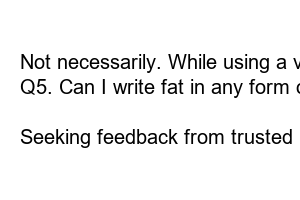지방 쓰는 방법
Title: The Art of Writing Fat in English: A Comprehensive Guide
Introduction:
Welcome to our ultimate guide on how to write fat in English! Whether you’re an aspiring writer, a content creator, or simply looking to enhance your written communication skills, this blog post is for you. In this article, we will explore various writing techniques to craft rich and captivating content that is both engaging and informative.
1. The Power of Descriptive Language:
Descriptive language plays a vital role in writing fat. It enables you to create vivid images in the reader’s mind, allowing them to fully immerse themselves in your words. By using expressive adjectives, adverbs, and sensory details, you can bring your writing to life. For example, instead of just saying “The cake was delicious,” try “The moist and decadent cake melted in my mouth, leaving me craving for another tantalizing bite.”
2. Amplify with Metaphors and Similes:
Metaphors and similes can add depth and complexity to your writing. They create connections between seemingly unrelated concepts and make your content more engaging. For instance, when describing a sunset, you can say “The sun dipped below the horizon like a flaming orange orb, setting the sky ablaze with a breathtaking display of colors.”
3. Craft Engaging Introductions:
The beginning of any piece of writing is crucial. A captivating introduction entices readers to continue reading. Hook them with a thought-provoking question, a surprising fact, or an intriguing anecdote. Grab their attention from the very first sentence, leaving them eager to explore what lies ahead.
4. Master the Art of Storytelling:
Humans have always been drawn to stories. Whether fiction or non-fiction, incorporating storytelling techniques into your writing can captivate your audience. Paint a vivid picture, create relatable characters, and present a compelling narrative that keeps readers hooked until the end.
5. Maintain a Clear and Concise Structure:
A well-structured piece of writing is easier to follow and comprehend. Use paragraphs to divide your content into logical sections. Begin each paragraph with a clear topic sentence, providing a smooth transition from one idea to the next. Bullet points and subheadings can also help break down complex information into digestible chunks.
6. Embrace Active Voice:
To make your writing more dynamic, opt for active voice over passive voice. This not only adds clarity but also provides a stronger and more impactful tone. For example, instead of saying “The cake was eaten by me,” say “I devoured the cake.”
7. Edit and Polish Your Work:
The key to writing fat is to revise and edit your work thoroughly. Eliminate unnecessary words, ensure consistent and cohesive ideas, and refine your grammar and punctuation. Reading your work aloud can also help identify any awkward phrasing or inconsistencies.
Summary:
Writing fat in English involves incorporating descriptive language, metaphors and similes, engaging introductions, storytelling techniques, structured writing, active voice, and thorough editing. By employing these strategies, you can create content that is captivating, informative, and memorable. So, unleash your creativity, play with words, and enrich your writing with expressive techniques to make it fat!
FAQs:
Q1. Can anyone become a proficient writer with practice?
Absolutely! Writing is a skill that can be developed over time. With consistent practice, dedication, and a willingness to learn, anyone can become a proficient writer.
Q2. How can I expand my vocabulary to write more expressively?
Reading extensively and exploring a wide range of genres can significantly expand your vocabulary. Additionally, using a dictionary, thesaurus, or vocabulary-building apps can help you discover new words and their contextual usage.
Q3. How important is it to proofread and edit my writing?
Proofreading and editing are essential steps in the writing process. They ensure that your work is error-free, coherent, and effectively conveys your intended message. Neglecting this step can diminish the impact of your writing.
Q4. Is it necessary to use complex words and sentences to write fat?
Not necessarily. While using a varied vocabulary is important, clarity and simplicity should not be compromised. The goal is to effectively communicate your ideas to your audience without confusing or alienating them.
Q5. Can I write fat in any form of writing, such as emails or professional documents?
Yes! Writing fat can be beneficial in all forms of communication. It adds depth and personality to your writing, regardless of the purpose or audience.
Q6. How can I receive feedback on my writing to further improve?
Seeking feedback from trusted individuals, joining writing groups or workshops, or even hiring an editor can help you obtain constructive criticism and valuable insights into enhancing your writing skills.

